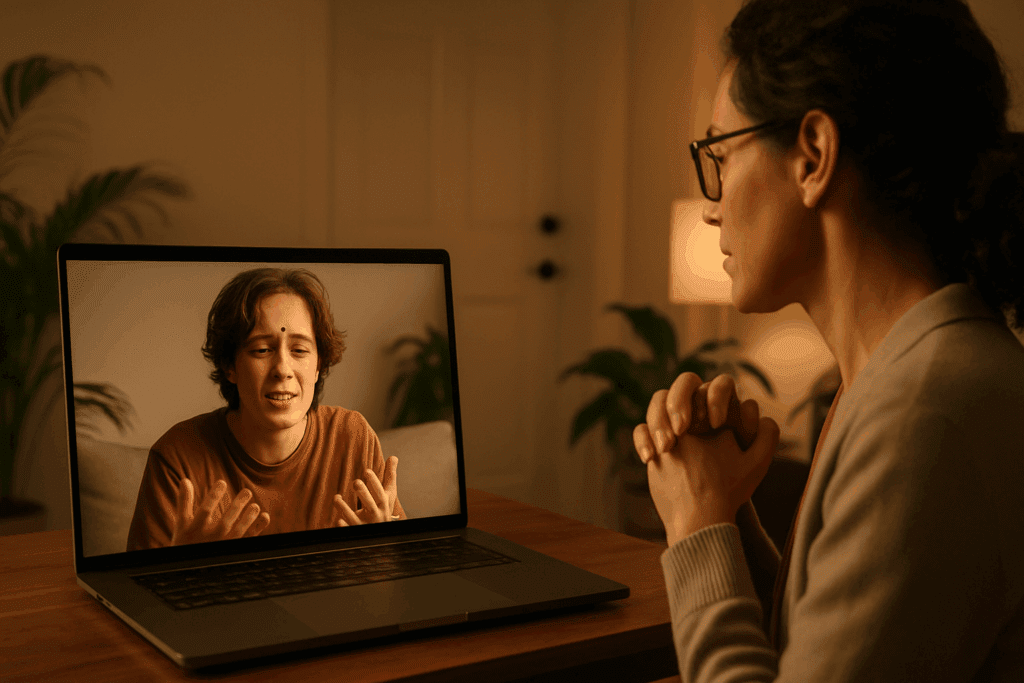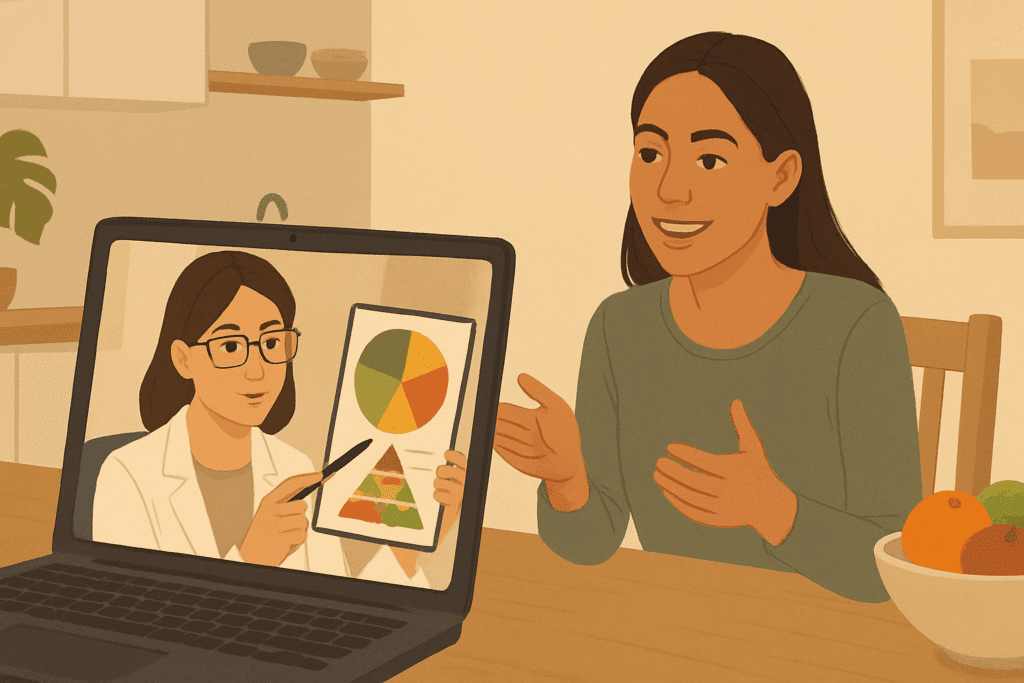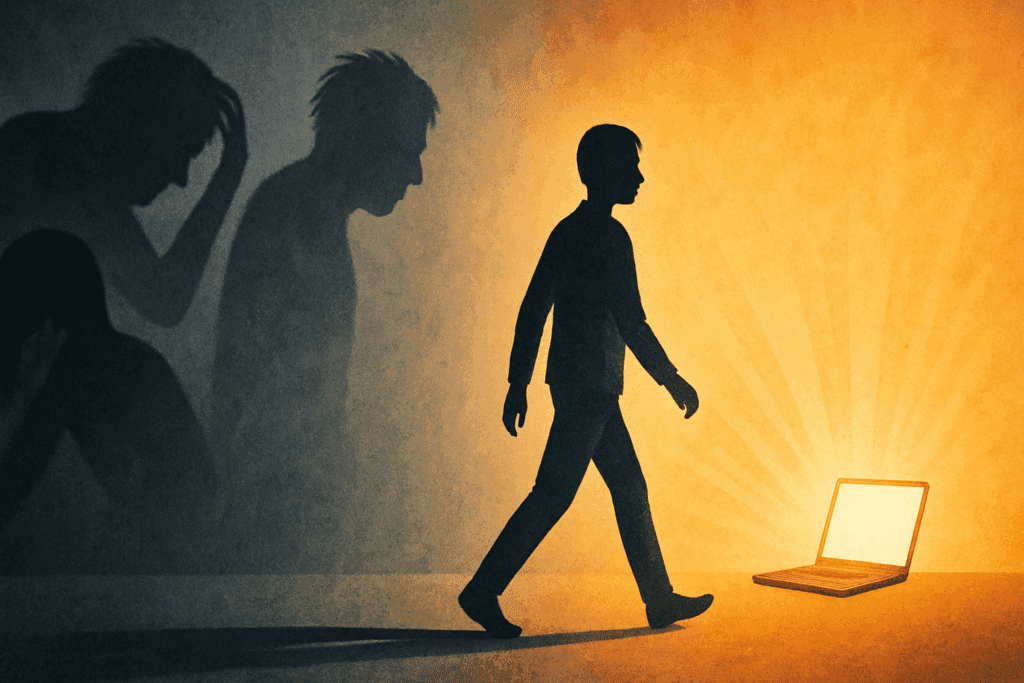The rise of virtual health care has dramatically transformed how individuals access mental health and nutrition services. Nowhere is this more impactful than in the realm of eating disorder recovery, where shame, isolation, and logistical barriers have historically prevented many from seeking help. Today, thanks to innovations in technology and a growing emphasis on holistic wellness, online eating disorder treatment has emerged as a powerful and flexible solution. Through this approach, individuals can receive evidence-based therapy, personalized nutritional guidance, and compassionate support from licensed professionals—all without leaving their homes.
You may also like: How to Stop Emotional Eating and Regain Control: Mindful Nutrition Strategies That Support a Healthier Lifestyle
This article explores how online eating disorder therapy fosters healing by combining the principles of mindful eating with the accessibility of virtual care. Drawing on clinical insights and real-world applications, we examine how this model enhances recovery outcomes, supports emotional resilience, and promotes sustainable lifestyle changes. By embracing digital solutions grounded in empathy and evidence, online eating disorder treatment offers a lifeline to those navigating complex relationships with food and body image.

The Evolution of Virtual Eating Disorder Treatment: Accessibility Meets Compassion
In the past, individuals struggling with eating disorders often faced numerous hurdles when trying to access treatment. From geographic limitations and high costs to long waitlists and societal stigma, the traditional model left many without timely or adequate care. Virtual eating disorder treatment disrupts this outdated system by removing many of these barriers. With the click of a button, patients can connect with credentialed therapists, registered dietitians, and peer support networks from virtually anywhere.
What sets online treatment apart isn’t just convenience—it’s the sense of agency it provides. For someone managing an eating disorder, regaining a sense of control is often one of the first steps toward healing. The ability to choose where and when therapy takes place, and to tailor sessions to one’s specific needs, reinforces autonomy and self-efficacy. Furthermore, online platforms often integrate secure messaging, meal tracking tools, and guided mindfulness exercises, creating a comprehensive ecosystem that supports recovery in real time.
Moreover, virtual care models have been particularly beneficial for adolescents and young adults, who are among the most affected by eating disorders. These age groups are digital natives, already comfortable with video calls and mobile apps. By meeting them in their comfort zones, online eating disorder therapy reduces the intimidation often associated with in-person clinical environments. This familiarity can lower psychological defenses and foster more honest, productive therapeutic exchanges.

Reframing Recovery Through Mindful Eating and Digital Therapeutics
Mindful eating is more than just a trend—it is a transformative practice rooted in awareness, intention, and nonjudgment. In the context of eating disorder recovery, it serves as both a therapeutic tool and a philosophical shift. Rather than framing food as the enemy or a source of fear, mindful eating encourages individuals to approach meals with curiosity, presence, and compassion. This approach aligns perfectly with the ethos of many online treatment platforms, which emphasize holistic healing over rigid behavioral correction.
Virtual programs often incorporate mindfulness-based interventions, such as guided meditations, body scans, and journaling exercises, into their therapeutic framework. These tools help patients develop a deeper connection with their physical sensations, emotional triggers, and thought patterns. As a result, individuals become better equipped to recognize and challenge disordered eating behaviors before they escalate. By integrating these practices into everyday routines, patients build resilience and self-trust—two essential components of long-term recovery.
In addition, many online eating disorder treatment programs partner with registered dietitians who specialize in intuitive eating. This method, which rejects restrictive dieting in favor of honoring internal hunger and fullness cues, complements mindful eating practices. Together, these approaches foster a more peaceful, sustainable relationship with food. Patients learn not just what to eat, but how and why—empowering them to nourish their bodies without fear or guilt.

Building Trust and Connection in a Virtual Environment
Skeptics often question whether virtual therapy can match the emotional depth and connection of in-person sessions. Yet research—and lived experience—suggests otherwise. In many cases, online eating disorder therapy allows for even deeper therapeutic relationships, thanks to the comfort and safety of the home environment. When individuals feel at ease, they’re more likely to disclose vulnerable thoughts, explore painful memories, and experiment with new coping strategies.
Licensed clinicians who specialize in eating disorders are trained to recognize the nuanced signs of distress, even through a screen. They employ evidence-based modalities such as Cognitive Behavioral Therapy (CBT), Dialectical Behavior Therapy (DBT), and Acceptance and Commitment Therapy (ACT), which have all been successfully adapted for virtual formats. These therapies provide structured, research-backed frameworks for addressing distorted thinking patterns, emotional dysregulation, and body image distress—all core features of eating disorders.
Peer support is another essential component of recovery that thrives in the online space. Virtual support groups and moderated forums provide opportunities for shared experiences, validation, and community building. Participants often find solace in knowing they are not alone, which can reduce feelings of isolation and shame. In turn, this sense of belonging reinforces motivation and accountability, both of which are critical for sustained recovery.

Addressing Nutritional Rehabilitation with Remote Guidance
Nutrition is a cornerstone of eating disorder treatment, and online programs are increasingly adept at delivering tailored guidance in this area. Registered dietitians who work within virtual eating disorder treatment platforms often conduct comprehensive assessments to understand each individual’s dietary history, medical needs, and psychological relationship with food. From there, they co-create meal plans and nutrition strategies that prioritize balance, flexibility, and gradual progress.
Unlike generic meal plans, these approaches take into account the complexities of each individual’s recovery journey. For example, someone recovering from anorexia nervosa may require a refeeding protocol that addresses medical complications and supports weight restoration, while another person with binge eating disorder might focus on stabilizing blood sugar levels and identifying emotional eating patterns. Through ongoing sessions and real-time tracking tools, dietitians can adjust recommendations as needs evolve.
Education is another key pillar of nutritional rehabilitation. Patients are often encouraged to explore topics such as metabolism, gut health, and the psychological impact of nutrient deficiencies. Understanding the science behind nutrition can demystify the eating process and reduce anxiety around food choices. Moreover, learning to trust one’s body signals and internal cues is reinforced by consistent support and positive reinforcement from care providers.

Overcoming Stigma and Cultivating Mental Wellness
Despite growing awareness, eating disorders are still often misunderstood and stigmatized. Many individuals delay seeking help due to fear of judgment, shame, or the mistaken belief that their struggles are not “severe enough.” Online eating disorder treatment helps dismantle these barriers by normalizing mental health care and emphasizing that recovery is possible for everyone, regardless of diagnosis or severity.
Virtual care offers a level of privacy and discretion that can be especially comforting to those hesitant to pursue traditional treatment. Logging into a session from one’s bedroom or living room creates a layer of emotional safety that encourages openness. This privacy also enables individuals to engage with treatment earlier, potentially preventing the escalation of symptoms into more dangerous territory. Early intervention is crucial, as eating disorders can become entrenched over time and lead to serious medical complications.
Mental wellness is not just the absence of disordered behaviors—it is the presence of emotional regulation, self-awareness, and a supportive internal dialogue. Online eating disorder therapy reinforces these qualities by providing tools to manage stress, build coping skills, and foster self-compassion. As patients begin to reclaim their mental space, they are better positioned to pursue goals, relationships, and passions beyond the eating disorder. In this way, treatment becomes not just about symptom reduction, but about life enrichment.

Sustaining Recovery with Ongoing Virtual Support
Recovery from an eating disorder is not a linear process. It involves setbacks, breakthroughs, and continuous growth. Online eating disorder treatment recognizes this complexity and provides ongoing support that adapts to the individual’s changing needs. After initial stabilization, many patients transition into maintenance programs that include check-ins, coaching, and relapse prevention planning.
Continuity of care is a major strength of the virtual model. Because patients can remain connected to their providers regardless of location or life changes, there is less disruption in treatment. This consistency helps maintain progress and prevents regression, especially during stressful periods such as academic transitions, career shifts, or family changes. In contrast, traditional models often involve abrupt terminations due to relocation, cost, or availability constraints.
Technology also plays a role in reinforcing healthy habits. Many platforms offer interactive apps that allow users to log meals, track emotions, and set recovery goals. These digital tools promote accountability and self-reflection while empowering individuals to take an active role in their healing. Some programs even include AI-powered features that detect patterns and provide personalized feedback, enhancing the precision and impact of care.
Families and caregivers can also benefit from virtual resources. Many programs offer educational modules, coaching sessions, and support groups for loved ones, helping them understand the recovery process and how to provide constructive support. When the entire support system is informed and aligned, the chances of long-term success increase significantly.
Frequently Asked Questions: Online Eating Disorder Treatment and Recovery
What makes virtual eating disorder treatment effective for individuals in rural or underserved areas?
One of the most valuable aspects of virtual eating disorder treatment is its ability to reach individuals in geographically isolated or medically underserved communities. In regions where specialized clinics are rare or nonexistent, access to care can be limited by distance, transportation challenges, and clinician shortages. Virtual platforms eliminate these obstacles by bringing therapy and nutritional guidance directly to a patient’s device, regardless of their location. This increases the likelihood of earlier intervention, which is critical for improving outcomes in eating disorder recovery. Additionally, many online eating disorder treatment programs include culturally sensitive components, making care more relatable and inclusive for diverse populations.
How does online eating disorder therapy address the role of family dynamics in recovery?
Family involvement plays a crucial role in the recovery journey, especially for adolescents and young adults. Online eating disorder therapy often integrates family-based treatment models that focus on restructuring eating behaviors within a supportive home environment. These virtual sessions can include parents, guardians, or partners and are tailored to educate and empower loved ones. In some programs, family members receive training on how to respond to emotional distress, set boundaries, and reinforce healthy habits. The convenience of virtual access ensures consistent participation, which can be difficult to maintain with in-person sessions due to work or caregiving responsibilities.
Can online eating disorder treatment be tailored for co-occurring conditions like anxiety or depression?
Yes, one of the strengths of online eating disorder treatment is its flexibility in addressing co-occurring mental health conditions. Many individuals with eating disorders also struggle with anxiety, depression, OCD, or trauma-related symptoms. Reputable virtual programs are staffed by multidisciplinary teams that include licensed therapists experienced in dual-diagnosis care. This allows for integrated treatment plans that address the root causes of both the eating disorder and associated psychological conditions. Some platforms even offer access to psychiatric consultations for medication management, ensuring comprehensive and coordinated care.
Are there specific benefits to online therapy for college students coping with disordered eating?
College students often face unique stressors, including academic pressure, social anxiety, and the challenge of living away from home. These factors can intensify eating disorder symptoms, yet campus health services may not offer specialized or timely support. Online eating disorder therapy offers a flexible, discreet solution that fits into busy class schedules. Students can attend sessions from their dorm rooms or apartments, reducing the likelihood of missed appointments due to logistical constraints. Additionally, some virtual programs provide 24/7 support features, which can be especially valuable during high-stress periods like exams or holidays.
How do virtual platforms ensure accountability in the absence of in-person monitoring?
Accountability is a key component of recovery, and virtual eating disorder treatment programs employ several strategies to maintain it. Many platforms incorporate meal logging, symptom tracking, and journaling features that allow both patients and providers to monitor progress between sessions. Video check-ins offer real-time feedback and can include therapeutic meal support, where clients eat with a clinician present via video. Some programs use wearable devices or app-based reminders to reinforce consistency. These tools create a feedback loop that promotes honesty and engagement without the need for constant physical supervision.
What kinds of technological tools are integrated into online eating disorder therapy programs?
Modern virtual eating disorder therapy often includes a suite of tech-enabled features to enhance engagement and outcomes. These may include secure messaging, guided meditation libraries, cognitive behavioral skill-building modules, and AI-assisted journaling tools that analyze thought patterns. Some platforms also use biofeedback technology to help clients regulate physiological stress responses. By combining traditional therapy methods with digital innovations, these programs offer a personalized and interactive healing experience. The result is an ecosystem of care that supports daily progress and self-reflection.
How does virtual care impact long-term relapse prevention?
Sustained recovery from an eating disorder requires ongoing support, and virtual treatment models are uniquely positioned to provide it. Unlike inpatient or time-limited outpatient programs, online eating disorder treatment can be extended indefinitely and adjusted as needs evolve. This continuity reduces the disruption that often leads to relapse after discharge from traditional care. Additionally, digital platforms make it easier to re-engage with services quickly if symptoms resurface. Features like monthly check-ins, peer support forums, and refresher modules help reinforce coping skills and resilience over the long haul.
Are there cost advantages to choosing online eating disorder treatment over traditional therapy?
Cost is a significant factor for many individuals seeking mental health support. Virtual eating disorder treatment is often more affordable than in-person care due to reduced overhead expenses for providers. Many programs offer tiered pricing models, subscription plans, or financial aid options, making them more accessible to a broader demographic. Furthermore, clients save money on transportation, childcare, and time off work—all common barriers associated with traditional therapy. The increased affordability does not necessarily compromise quality, as many leading virtual platforms are accredited and employ highly credentialed professionals.
What innovations are shaping the future of online eating disorder therapy?
The future of online eating disorder therapy is being shaped by a combination of clinical research, user feedback, and technological advancement. Innovations such as predictive analytics, personalized treatment algorithms, and virtual reality exposure therapy are beginning to be explored. These tools aim to enhance engagement, personalize interventions, and simulate real-world challenges in a controlled digital environment. As telehealth regulations become more streamlined, cross-state licensure will allow for even broader access to expert providers. Ultimately, the goal is to make treatment more adaptive, proactive, and inclusive.
Can online eating disorder therapy work for individuals who have previously relapsed in traditional treatment settings?
Absolutely. Many individuals turn to online eating disorder therapy after feeling disillusioned by conventional treatment approaches. The flexibility, privacy, and personalized pace of virtual care can foster renewed motivation and engagement. Online platforms also empower clients to take an active role in shaping their treatment goals, which can lead to greater internal commitment. For some, the less clinical, more conversational environment of online sessions helps reduce resistance and defensiveness. These factors make virtual care a valuable option for individuals seeking a fresh start on the road to lasting recovery.
A Mindful Future: How Online Eating Disorder Therapy Redefines Recovery
The integration of virtual care and mindful healing has revolutionized how we approach eating disorder treatment. No longer confined to physical clinics or constrained by geography, individuals now have access to compassionate, high-quality care that fits into their real lives. Online eating disorder therapy empowers people to heal on their own terms, surrounded by tools and professionals that honor their unique journeys.
By weaving together evidence-based therapy, nutritional rehabilitation, and mindfulness practices, this approach creates a robust framework for sustainable recovery. It acknowledges that healing is not just about food or weight—it’s about self-worth, emotional balance, and the freedom to live authentically. Through the accessibility of online eating disorder treatment, more individuals can find hope, resilience, and a renewed relationship with their bodies.
As technology continues to evolve and awareness grows, the future of eating disorder recovery is undeniably digital—and deeply human. With the right support and intentional care, healing is not only possible, but profoundly transformative. For those seeking a path forward, virtual eating disorder treatment may be the bridge that leads to lasting wellness and peace.
Was this article helpful? Don’t let it stop with you. Share it right now with someone who needs to see it—whether it’s a friend, a colleague, or your whole network. And if staying ahead on this topic matters to you, subscribe to this publication for the most up-to-date information. You’ll get the latest insights delivered straight to you—no searching, no missing out.

